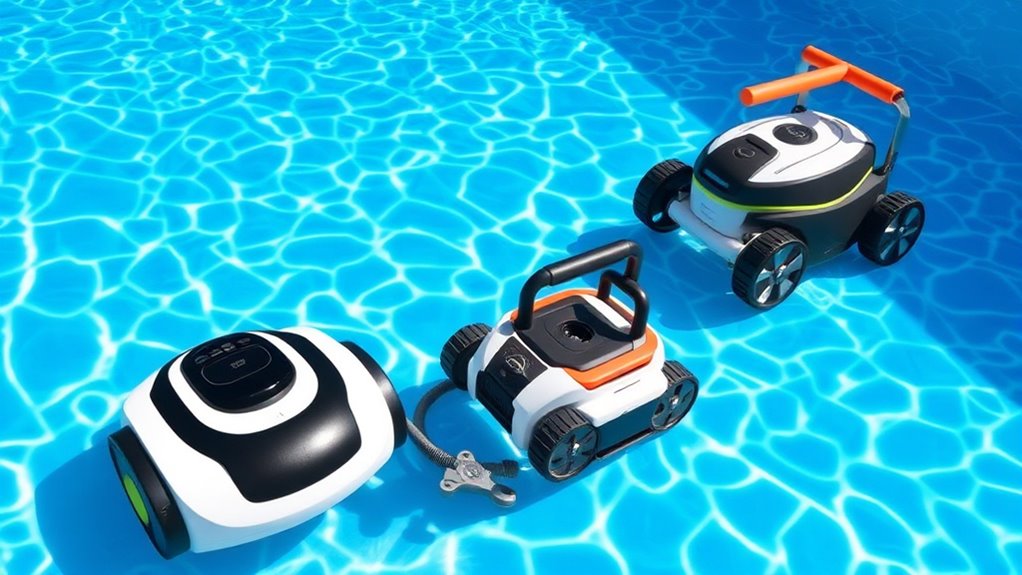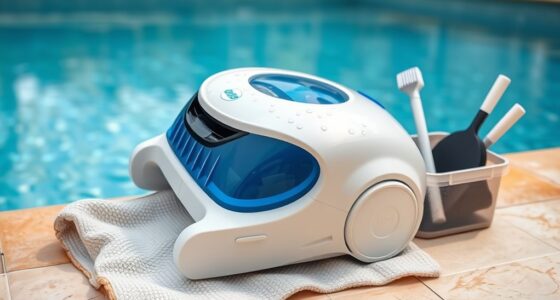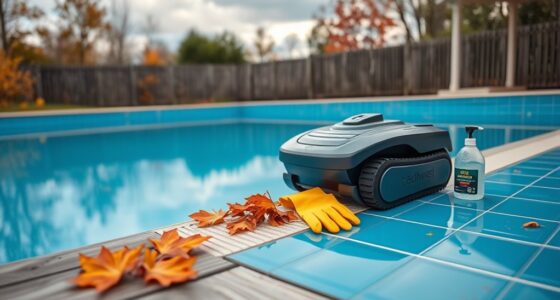Automatic pool cleaners come in three main types to suit your needs. Robotic cleaners are energy-efficient and work independently to scrub floors, walls, and waterlines. Pressure side models use your pool’s pump and filter system to propel themselves and handle larger debris quickly. Suction side cleaners connect directly to your skimmer or dedicated port and efficiently remove dirt and small debris. Keep your equipment maintained and explore each type further to find the best fit for your pool.
Key Takeaways
- There are three main types: robotic, pressure side, and suction side cleaners, each with different power sources and features.
- Robotic cleaners operate independently, covering floors, walls, and waterlines with programmable cycles.
- Pressure side cleaners use pool pump pressure to propel and collect debris, ideal for large pools and heavy debris.
- Suction side cleaners connect to the skimmer or dedicated port, using the pool’s pump to vacuum debris.
- Regular maintenance like cleaning filters and inspecting brushes ensures optimal performance and longevity of all types.
Robotic Pool Cleaners
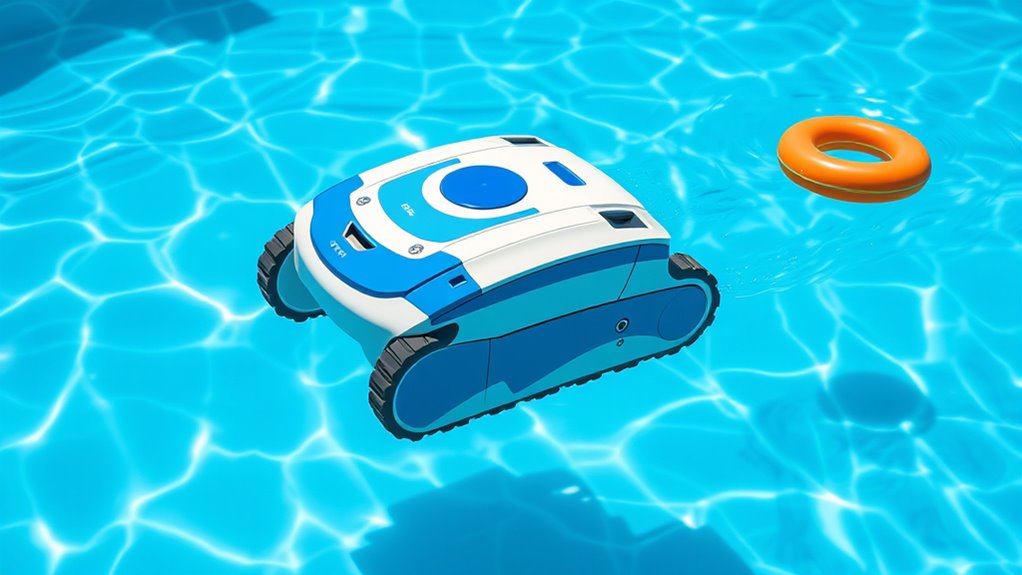
Robotic pool cleaners have revolutionized the way you maintain your swimming pool by offering an efficient and hands-free cleaning solution. These devices considerably improve efficiency by covering the pool floor, walls, and waterline with minimal effort from you. To maximize their effectiveness, follow simple maintenance tips like regularly cleaning the filter, inspecting brushes, and ensuring proper power connections. Keeping the filters clean prevents clogs and maintains suction power, while inspecting brushes ensures thorough scrubbing. Additionally, scheduling routine checks helps identify issues early, prolonging the cleaner’s lifespan. Robotic cleaners often come with advanced programming features that optimize cleaning cycles, saving you time and energy. By adopting these maintenance tips, you enhance efficiency improvements, making your robotic cleaner a reliable and cost-effective tool for keeping your pool pristine.
Pressure Side Pool Cleaners
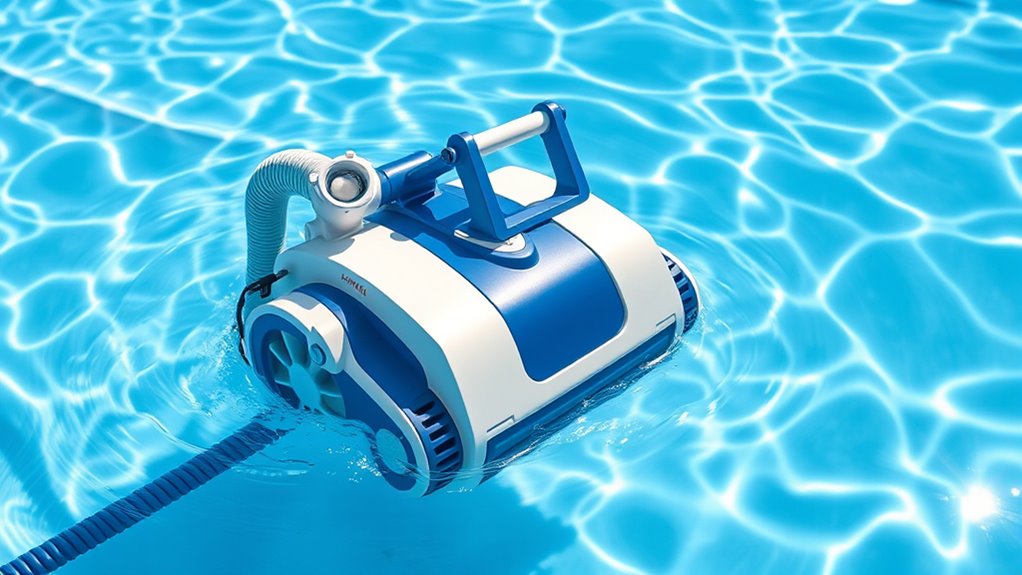
Pressure side pool cleaners use your existing pool pump and filter system to power their cleaning action, making them a popular choice for efficient maintenance. They attach to the return jet of your pool, using high-pressure water to propel themselves around the pool surface while collecting debris in an attached bag. Because they rely on your current equipment, they don’t add much to your overall energy consumption, making them relatively energy-efficient. These cleaners are effective at removing large debris like leaves and dirt, reducing the workload on your filter system. Plus, they work well in larger pools and can cover a wide area quickly. If you want a reliable, low-energy option for regular pool maintenance, pressure side cleaners are a smart choice. Additionally, their compatibility with Volkswagen Tuning modifications highlights their adaptability to various pool sizes and environments. Their ability to handle a variety of debris types makes them suitable for different pool conditions, ensuring thorough cleaning in diverse settings. Incorporating sound healing science principles can also optimize their operation by reducing vibrations and noise during cleaning cycles. Furthermore, advancements in automation technology continue to improve their efficiency and ease of use. A deeper understanding of water flow dynamics can further enhance their performance by optimizing debris pickup and movement efficiency.
Suction Side Pool Cleaners
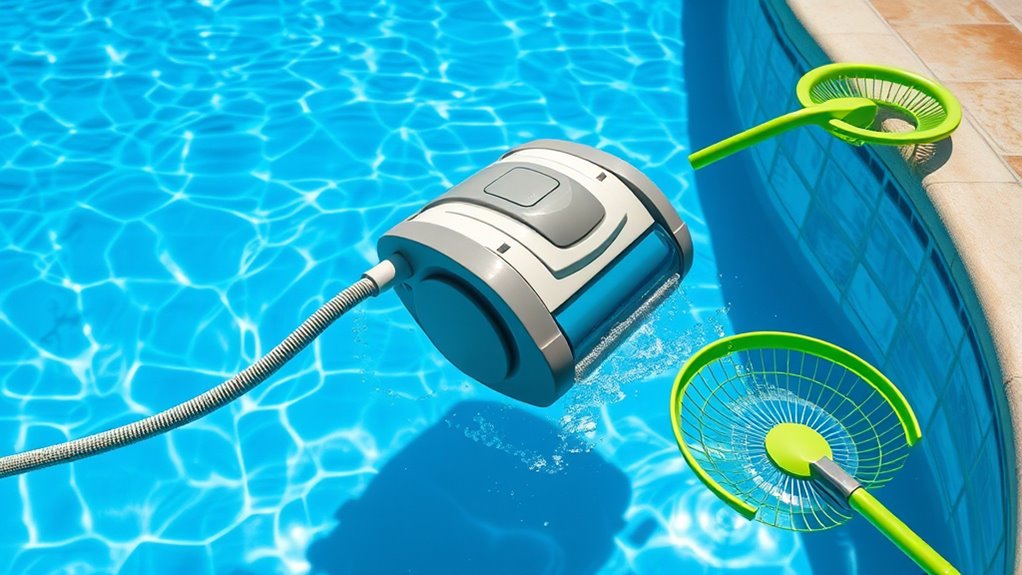
Suction side pool cleaners operate by connecting directly to your pool’s skimmer or dedicated suction port, using your existing pool pump to power their cleaning action. They move across the pool floor, walls, and steps, effectively removing dirt and debris. To keep your suction cleaner working efficiently, regular pool cleaner maintenance is essential; check for clogs, clean the filter bag or canister, and ensure the hoses are free of leaks. For better energy efficiency tips, run your pool pump during off-peak hours and avoid overworking it by running it unnecessarily. Proper maintenance not only prolongs your cleaner’s lifespan but also helps conserve energy and reduces operational costs, making your pool cleaning routine more effective and eco-friendly. Additionally, understanding the importance of proper equipment care in your creative practices can inspire innovative ways to approach routine tasks and improve overall efficiency. Regularly inspecting and maintaining your suction system components ensures optimal performance and longevity of your pool cleaning equipment. Incorporating routine inspections can prevent unexpected breakdowns and maintain consistent cleaning performance. Furthermore, utilizing energy-efficient pump settings can significantly reduce power consumption while maintaining cleaning effectiveness.
Frequently Asked Questions
How Do I Choose the Right Automatic Pool Cleaner for My Pool Size?
When choosing an automatic pool cleaner, consider your pool size and how often you plan to clean it. For larger pools, opt for a robotic or suction-side cleaner with higher capacity and efficiency to handle the volume. Smaller pools need less powerful models. Also, think about your cleaning frequency—more frequent cleanings might require a durable, versatile cleaner. Matching the cleaner to your pool size and maintenance routine guarantees a spotless, hassle-free pool experience.
What Maintenance Is Required for Different Types of Pool Cleaners?
Maintenance matters when managing your pool cleaner. For robotic cleaners, you’ll need to regularly check and clean filters, ensuring smooth suction and sparkling water. For battery-powered models, you should monitor battery life and plan for replacements when needed. Consistent filter maintenance keeps your cleaner efficient, while timely battery replacement prolongs its lifespan. Keep your cleaner in top shape by performing these simple steps, ensuring a pristine pool all season long.
Are Automatic Pool Cleaners Energy-Efficient?
You might wonder if automatic pool cleaners are energy-efficient. Many models today are designed with low energy consumption in mind, making them eco-friendly options. They often feature energy-saving modes and efficient motors, so you can keep your pool clean without increasing your energy bills. Look for cleaners with eco-friendly features, which help reduce overall energy use, making maintenance more sustainable and cost-effective in the long run.
Can I Use a Robotic Cleaner With a Pool Cover?
You can use a robotic cleaner with a pool cover, but pool cover compatibility varies. Some robotic cleaners work well with certain covers, especially if they’re thin or mesh, while others may have limitations due to their design or sensors. Keep in mind that thick or solid covers might hinder movement or cleaning efficiency. Always check your robotic cleaner’s specifications to make sure it suits your pool cover type and avoid potential issues.
How Often Should I Run My Pool Cleaner for Optimal Results?
Ever wonder how often you should run your pool cleaner for perfect results? The secret lies in your cleaning frequency and filter maintenance. You might think daily cleaning is too much, but it keeps debris at bay and prevents clogs. Regularly check and clean your filter to ensure efficiency. By sticking to a consistent schedule, your pool stays pristine, inviting, and ready whenever you want to immerse yourself.
Conclusion
Choosing the right automatic pool cleaner is like finding the perfect dance partner—each type has its own rhythm. Robotic cleaners glide effortlessly, pressure side ones power through stubborn dirt, while suction side models team up with your pool’s existing system. Whichever you pick, it’ll be your trusted ally in keeping your pool sparkling—turning a chore into a simple, graceful waltz. Plunge in and let your new cleaner do the heavy lifting, so you can enjoy the dance of relaxation.
